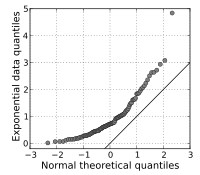
Photo from wikipedia
ABSTRACT To investigate the vertical and horizontal impact of reservoir scale on the amplitude‐versus‐offset characteristics, we conduct seismic numerical simulations on models containing spatially confined lithologic units with different scales.… Click to show full abstract
ABSTRACT To investigate the vertical and horizontal impact of reservoir scale on the amplitude‐versus‐offset characteristics, we conduct seismic numerical simulations on models containing spatially confined lithologic units with different scales. We find that the reservoir scale has a nonlinear effect on the amplitude‐versus‐offset intercepts and gradients. As the reservoir width increases, amplitude‐versus‐offset intercept and gradient both first increase, then decrease, and finally remain stable. The amplitude‐versus‐offset intercept is maximum when the reservoir width is 80% larger than the Fresnel zone radius, whereas the amplitude‐versus‐offset gradient peaks at 1.5 times the Fresnel zone radius. Both amplitude‐versus‐offset intercept and gradient are approximately proportional to the reservoir width prior to reaching their maxima. When the lateral extent of the reservoir is more than three times the Fresnel zone radius, the amplitude‐versus‐offset attributes are constant. Modelling the reservoir thickness shows that intercept and gradient behave in a manner similar to that of tuning of thin beds. Both the amplitude‐versus‐offset intercept and gradient first increase and then decrease with the thickness, peaking at the tuning thickness. The thickness contribution to amplitude‐versus‐offset variations is negligible when the thickness is larger than 1.6 times of the tuning thickness. Considering the magnitude of the changes in amplitude‐versus‐offset intercept and gradient caused by reservoir scale, the width causes a maximum 433% intercept increase and a 344% gradient increase, whereas the thickness causes a maximum 100% intercept increase and a 73% gradient increase. Cross‐plotting the amplitude‐versus‐offset intercept and gradient shows the reservoir scale change gives rise to an anti‐clockwise spiraling effect. In conclusion, the lateral and vertical extents of the reservoir both play an important role in amplitude variation with offset. Our analysis shows that the lateral reservoir extent has a larger impact on the amplitude variation with offset than the vertical tuning effect.
Journal Title: Geophysical Prospecting
Year Published: 2017
Link to full text (if available)
Share on Social Media: Sign Up to like & get
recommendations!